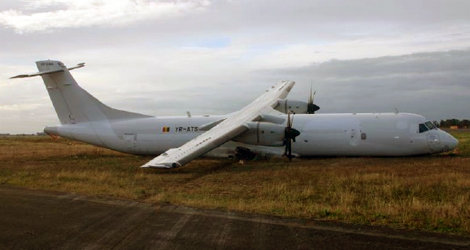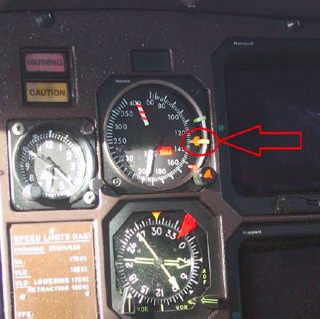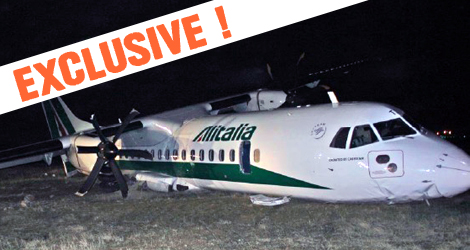Alitalia flight AZ1670 operated by Carpatair with ATR72-212A (ATR72-500) registration YR-ATS departed Pisa (LIPR) bound to Rome Fiumicino Airport (LIRF) on the 2nd of February, 2013, at 18.44 with 4 crew members and 46 passengers on board.

Carpatair – ATR72-500 (YR-ATS) flight AZ1670
After an uneventful approach in Rome Fiumicino, with gusty cross winds, according to the ground traces and by additional evidence acquired, it seems that the Carpatair flight AZ1670 touched the runway at the airport of Fiumicino at 19:32 , close to the center line of runway 16L, at a distance of about 560 m from the threshold. After the first contact with the runway, the aircraft would attempt three more times the touch down, during which the nose gear and later the main landing gear collapsed.
After the last contact (4th and last one) with the runway, Carpatair flight AZ1670 would permanently be supported by the fuselage, crawling for approximately 400m before stopping completely.
Throughout the swiping the aircraft’s trajectory was leaning to the right, only to stop on the grass, at about 30m from the edge of the runway, near the intersection called “DE”.
During the course of the sweep, the aircraft was leaning to the right by performing a rotation of about 170° on its vertical axis, stopping with the nose oriented at 330° magnetic degrees.
As soon as the Carpatair flight AZ1670 stopped, the two flight attendants, assisted by the crew members of another company on board as positioning crew, took care of the process of the evacuation of passengers, who, after exiting the aircraft fuselage, waited for the authorities to come and help.
The first emergency vehicles of firefighters came to the scene after 10 minutes and due to the absence of a possible fire condition, they positioned themselves around the aircraft ready for intervention.
A doctor, who arrived at the scene at the same time of the Police Department, would provide for the immediate relief of the wounded ones while carrying out the process of the nursing triage in order to encode the rescue urgency.
The morning of the 3rd of February, the ANSV staff, returned to the crash site of Carpatair flight AZ1670 for further operational inspection, acknowledged that, after the first inspection, the livery of the Italian carrier for which the flight had been operating, had been removed from the aircraft leaving out only the identification marks and the flag of nationality.

Carpatair – ATR72-500 (YR-ATS) flight AZ1670 : livery and logo of the company where wiped out during the night.
These are the evidences of the investigation of Carpatair flight AZ1670 accident :
- The crew members were in possession of the necessary aeronautical and qualified titles for the flight concerned.
- During the investigation there was nothing that could reveal the non good psychophysical condition of the crew members.
- The aircraft was properly equipped, with the documents still valid and the maintenance had been carried out in accordance to the local regulations and the approved procedures.
- There was no evidence that suggest that before the event the aircraft had been damaged.
- The radio aids used at the airport of Fiumicino, in particular those necessary for the approach and the Instrument Landing System (ILS) for runway 16L, were properly working.
- The radio communications between the YR-ATS operating the flight AZ1670, and the relevant air traffic control units were held regularly without critical elements.
- The Carpatair flight AZ1670 accident occurred in night light conditions during the landing phase at the runway 16L of Rome Fiumicino’s airport.
- At 19:30’50” the TWR of Rome Fiumicino, after giving the clearance to land, would again provide the crew of the YR-ATS the direction an the intensity of the wind: 250 degrees, with an intensity of 22 knots, with gusts up to 37. From the evidence obtained it emerged that the TWR, in all of the communications with the other aircrafts landing, tended to highlight the value of the gusts, as it was of a significant value. Upon landing the weather conditions were characterized by the presence of crosswinds and wind gusts that were of a higher value than that allowed for the accident’s aircraft .
- The aircraft touched violently the ground with the front gear while “pitching down” in an excessive way and having an approach speed higher compared to the one provided in the OM. In particular, at the moment of the first contact with the ground, the pitch angle was -2.6 degrees with a speed of 125 KIAS and there was no detection of opposite inputs by the two crew members. The above data indicates that the aircraft touched the runway in a controlled flight.
- From the traces found on the runway and by additional evidence acquired it emerged that the aircraft touched the Rome Fiumicino’s airport runway at 19:32’03”, close to the center line of runway 16L, at a distance of about 560m from the threshold. After the first contact with the runway, the aircraft would attempt the touch down three more times (in order to try to land it), during which the nose gear and later the main landing gear collapsed. After the last contact (4th and last one) with the runway, the aircraft would permanently be supported by the fuselage, crawling for approximately 400m before stopping completely. Throughout the swiping the aircraft’s trajectory was leaning to the right, only to stop on the grass, at about 30m from the edge of the runway, near the intersection called “DE”. During the course of the sweep, the aircraft was leaning to the right by performing a rotation of about 170° on its vertical axis, stopping with the prow nose oriented at 330° of the magnetic field.
- During the second touchdown with the runway, the engines went out, due to mechanical damage at the linkage of the engine control levers (in particular the ones of the CLA) which were damaged from the collapsing of the front landing gear.
- Following the incident no fire was detected.
- There is no evidence, from the analysis of the CVR, of the execution, by the crew, of the “landing briefing”, as suggested by the OM of the company.
-

Captain’s speed bug on anemometer (130 Kts) – Carpatair – ATR72-500 (YR-ATS) flight AZ1670
The Captain (PF) decided to maintain an approach speed (130 KIAS) higher than the one suggested in the OM (which was calculated at 118 KIAS [maximum]); the first officer (PNF) behaved assertively and uncritically, accepting twice the quoted speed value communicated by the Captain.
- The Captain (PF) made the aircraft touch the runway with the front landing gear having a pitch angle of -2.6 degrees, value not consistent with neither a technique applicable to a normal landing, nor with the provisions in the OM.
- The Captain and the first officer had both hands on the control columns before and after the first contact; having used simultaneously opposite inputs to the flight controls, the interconnection decoupling between the commands was a direct result of these acts.
- After the first contact with the ground, the procedure called balked landing had not been applied as provided in the OM of the company.
- The evacuation took place without major problems, coordinated by the flight attendants assisted by the CMG (Crew Must Go, positioning crew) of other company present on board.
- The search and rescue operations were carried out during nighttime in good-visibility conditions.
- Rescuers reached the location of Carpatair flight AZ1670 10 minutes after the activation of the state of emergency.
- Communications between the TWR and the Fire Department were not properly effective and no GRID-MAP has been used as suggested in the Safety Guide (Manuale Rosso) of Rome Fiumicino’s airport.
Cause of the Carpatair flight AZ1670 accident was identified as “human factor“.
In particular was caused by an improper conduct by the PF (Captain) during landing, not consistent with what is expected from the OM in an environment characterized by the presence of significant problems (presence of crosswind with the values at the limit /excess of those permitted for the ATR 72) and in the absence of an effective CRM.
The event may have been influenced by the following factors.
- The not making of the “landing briefing”, which, in addition to being required by the company’s standards, would be an important opportunity to put a vital factor for ensuring the safety of the operations.
- Maintaining a VAPP significantly higher than the expected.
- The belief of the Captain (PF), resulting from its significant general and specific experience on the aircraft , that he could still be able to conduct a safe landing despite the presence of critical wind conditions for the type of aircraft.
- The substantial experience gap existing between the captain and the first officer, who reasonably accepted the Captain’s decision, making ineffective the CRM techniques.
Download Original Report Download English Report


Interesting read. Shows how important respecting limits is.